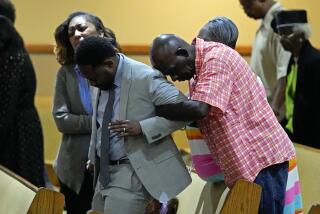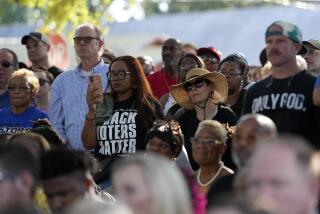Florida City Officials Urge Calm, Amass Forces After Riot
- Share via
ST. PETERSBURG, Fla. — Officials of this smoldering city appealed for calm Friday, even as they marshaled a vast force of riot-ready police and National Guard troops to respond to any repeat of the arson and looting outbreak that followed the fatal police shooting of a teenager the night before.
As the sun went down over the Gulf of Mexico, tensions were on the rise--especially in the predominantly black neighborhood of south St. Petersburg.
“We are asking for calm, but the history is that it doesn’t end in one night,” said Mayor David Fischer, who declared a state of emergency Friday.
Although officials urged residents to stay off the streets and announced a restriction on the sale of firearms and gasoline in some sections of the city, no curfew was imposed.
Truman Smith--father of the 18-year-old black man killed after he was stopped by a white officer for speeding--also urged calm. “The killing must stop,” he said. “There’s been enough killing as it is.”
Nonetheless, more than 400 police officers, backed by 200 Florida National Guard troops, were equipped in full riot gear--batons, shields, helmets and vests--and were standing by.
In the aftermath of Thursday’s disturbance, Fischer called for the U.S. Civil Rights Commission to investigate race relations in the city of 240,000, which just two weeks ago basked in the national spotlight when the vice presidential debate took place here. Four years ago, a similar look from the rights commission got this city a failing grade. Two years later, that grade was upped to a B.
The U.S. Justice Department dispatched a team of investigators, and Fischer asked the state attorney to take charge of the probe into the shooting that touched off the arson fires and violence.
In Atlanta, President Clinton called the rioting “unfortunate violence” and praised clergy who were working to keep the peace.
Police said the routine traffic stop turned tragic after Officer Jim Knight and his partner stopped a car that was traveling faster than 70 mph. Knight stood in front of the car, police said, ordering the driver to get out, when the vehicle suddenly lurched forward. Knight fired several shots through the front windshield, killing Tyron Lewis. A passenger in the car was not injured.
Within hours of that 5:30 p.m. shooting--the fifth involving police and motorists in St. Petersburg this year--the streets were jammed with hundreds of people, many with a different version of what occurred. One version suggested that the driver had his hands up and was attempting to exit the car when he was shot.
By midnight, at least 11 people--including several police officers and at least one news photographer--had been injured. Twenty people had been arrested and some 25 arson fires had been set, mostly targeting stores and vehicles--including a television station’s satellite truck and a police cruiser.
*
Among the buildings torched in the heart of the neighborhood’s business strip was a police substation. That fire spread to an adjacent AIDS food pantry. “I know it was not aimed at us,” pantry worker Diana Walters said. “But they are hurting so many people.”
Several leaders in the black community said the disturbance following the shooting revealed the explosive tensions that exist between police and residents there. “The situation in St. Petersburg has been a festering sore that needed to be lanced,” said Sevell C. Brown, president of the local chapter of the Southern Christian Leadership Conference. “But it was not lanced. And it erupted last night, and fell all over St. Pete.”
Brown said that black residents of St. Petersburg have felt especially betrayed by Fischer’s apparent lack of interest in their concerns about police harassment, particularly after they gave him their overwhelming support in his ’93 race against former Police Chief Ernest Curtsinger.
Police Chief Darrel Stephens replaced Curtsinger in 1992 and was credited with improving relations between police and black residents, especially by doing away with Curtsinger’s commando-style narcotics squad, known as the Green Team.
But tensions had been building. In October 1993, some 300 people in the same neighborhood affected by Thursday’s violence threw rocks and bottles after a suspect scuffled with police as he was being arrested. And Stephens has come under fire from a community organization called the National People’s Democratic Uhuru Movement, which claims he has done little to stop police from harassing people who congregate in public parks.
More to Read
Sign up for Essential California
The most important California stories and recommendations in your inbox every morning.
You may occasionally receive promotional content from the Los Angeles Times.













